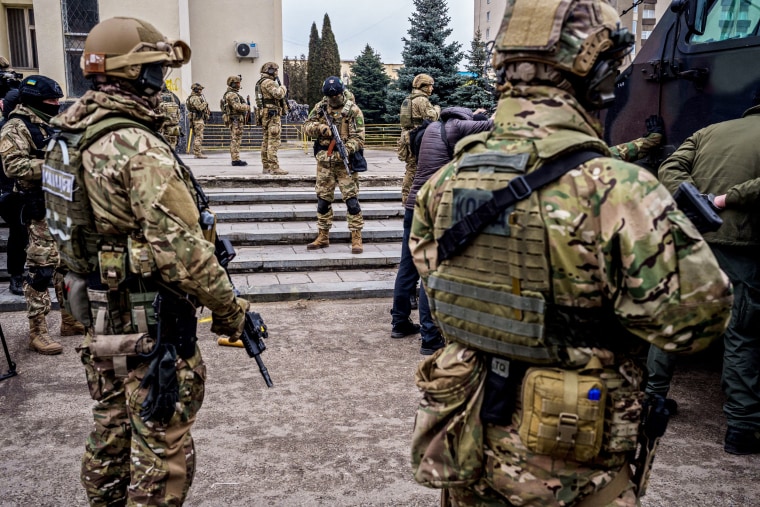Ukrainian agents have pursued drone attacks inside Belarus and Russia, contrary to U.S. and Western wishes, and leaders in Kyiv have considered further targets outside Ukraine, according to a batch of leaked U.S. documents that appear to expose national security secrets.
NBC News obtained more than 50 of the leaked documents, which have revealed much about Ukraine’s military strengths and weaknesses. The documents posted online seem “to contain sensitive and highly classified material,” though some may have been altered, Pentagon spokesperson Chris Meagher said on Monday.
Two documents appear to show Ukraine launching operations inside other countries, though some allied nations have said any such actions might cause them to reconsider their ongoing support for Kyiv.
John Bolton, who served as national security adviser during the Trump administration, said the disclosures show how damaging the leaked documents could be.
“Releasing this information could be intended to undercut Western support for Ukraine by showing potential operations cross border and by revealing purported weaknesses in Ukraine’s air defense capabilities,” he said.
One document, marked “Top Secret,” notes two separate attacks allegedly orchestrated by Kyiv that appear to have minimally damaged two Russian targets outside of Ukraine: a military airfield outside Minsk, Belarus, and a gas compressor station in the Moscow suburbs.
In the first instance, officials with Ukraine’s Security Service, Kyiv’s main intelligence agency, assessed that their agents in Belarus had disobeyed orders and attacked a Russian surveillance aircraft at a Belarusian airfield on Feb. 26, according to the document.
The document alleges the agents used a quadcopter drone and caused “minor damage” to the plane, a RUS A-5OU, which the Russian state-owned weapons developer Rostec calls a “flying radar” that is capable of operating as a mobile command center.
A spokesperson for the Security Service of Ukraine said the agency would be willing to comment “after Ukraine’s victory.”
Belarusian President Alexander Lukashenko has allowed Russia to station its troops and military equipment in Belarus. He has threatened to enter the war on Russia’s side if Belarus is attacked by Ukraine.

Lukashenko had previously alleged without evidence that the Feb. 26 attack was coordinated by Ukraine and the U.S.’s intelligence operations. Belarusian dissidents took credit for the damage and said on Telegram that participants in the operation were “safe, outside the country.”
A week later, according to the state news agency Belta, Lukashenko said that a “terrorist” trained by Washington and Kyiv had orchestrated the attack and that “more than 20 accomplices who are in Belarus have been detained. The rest are hiding.”
“If you think that by throwing down this challenge, you will drag us into a war tomorrow,” Lukaschenko said in comments aimed at the U.S. and Ukraine, “you are mistaken.”
A similar incident occurred two days later in Russia, according to the same document. Russian officials reported that “Ukrainian forces” used a drone on Feb. 28 in an attempt “to strike a gas compression station in Moscow’s suburbs.” It is unclear whether the attempt caused any damage or who specifically caused the attack, but since the start of the conflict Russian news agencies have reported numerous explosions inside the country near important infrastructure that do not have a clear cause.
Separately, a second document from the trove says that on Feb. 28 Ukrainian President Volodymyr Zelenskyy “suggested striking Russian deployment locations in Russia’s Rostov Oblast,” which borders southeastern Ukraine, with unspecified drones.
The document alleges that in conversation with Ukrainian Armed Forces Commander-in-Chief Gen. Valeriy Zaluzhnyy and a second unidentified Ukrainian official, Zelenskyy “expressed concern” that Ukraine did not have the long-range missile capabilities to strike Russian troop deployments in Russia. He suggested Ukraine attack Russian troop locations across the border with drones instead.
The Biden administration has declined to provide Ukraine long-range missile systems and even newer jets out of fear that Ukraine would strike targets within Russia, which is against U.S. policy.
The unnamed second official said that Ukraine’s capabilities could reach Tuapse, Russia, which is on the Black Sea Coast more than 100 miles south of Rostov Oblast. Zelenskyy said striking that far was “unnecessary.”
Zelenskyy’s office did not immediately respond to a request for comment.
Putin spokesperson Dmitry Peskov said on Monday that the Kremlin was reviewing the leaked documents. He declined to comment on how the documents found their way to the internet, but said that Russia is often first to be blamed for America’s misfortunes.
NBC News has not independently confirmed the information outlined in the leaked documents.
The U.S. government has set up an “interagency effort” to investigate the leak, said the Pentagon's Meagher, “with a focus on assessing the impact these photographed documents could potentially have on U.S. national security and on our allies and partners.”
The Pentagon said it is reaching out to allies about the leak, and is checking the veracity of the documents, but it declined to say how many documents may have been leaked, how many people inside the government had access to the documents, which allies it has contacted and who at the Defense Department will be leading the review. The Biden administration has declined to comment on any of the details appearing in the documents.
National Security Council spokesperson John Kirby also couldn’t say on Monday whether more documents might be released.
“We don’t know. We truly don’t,” he said during the White House press briefing.

